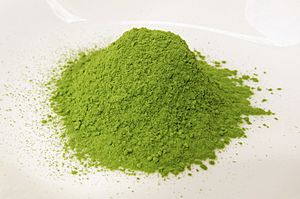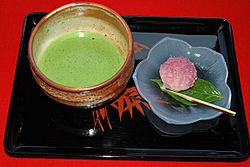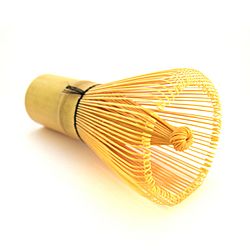Matcha facts for kids
| Type: | Green |
|
|
|
| Other names: | 抹茶, "fine powder tea" |
| Origin: | China |
|
|
|
| Quick description: | Stone ground Japanese style green tea |
|
|
|
Matcha (pronounce: "MA-cha") also spelt maccha (Japanese: 抹茶), is a fine, powdered green tea. It is used in Japanese tea ceremony and for dying and flavouring foods such as mochi and soba noodles, green tea ice cream and different types of wagashi (Japanese confectionery). The most famous Matcha-producing regions are Uji in Kyoto (tea from this region is called "Ujicha"), Nishio in Aichi (tea from this region is called "Nishiocha") both on the main island of Honshū; Shizuoka, and Kyushu.
Matcha costs more money than other kinds of tea. Its price depends on its quality (how good it is). It can be hard to find outside Japan, and also the special things that are used to make it and drink it.
Contents
History
Powdered tea, stored and traded as tea bricks, seems to have been invented in China during the Song Dynasty (960-1279). Making and drinking powdered tea was formed into a ritual (special ceremony) by the Chan Buddhists. These Buddhists use to drink from the same bowl as a sacrament. Chan Buddhism (also known in Japanese as Zen), and powdered tea, were brought to Japan in 1191 by the monk Eisai. Powdered tea was slowly forgotten in China, but the 16th century tea master Sen no Rikyu made the rules of the Japanese tea ceremony. He said that matcha was the correct tea to use.
Production
The preparation of matcha starts several weeks before harvest. At that time, the tea bushes are covered so that they do not get direct sunlight. This makes it grow slower and turns the leaves a darker shade of green. It also causes amino acids to be made, and these make the tea taste sweeter.
After harvesting, if the leaves are rolled out before drying as usual, the result will be gyokuro (jewel dew) tea. However, if the leaves are laid out flat to dry, they will crumble and become known as tencha (展茶). Tencha can then be de-veined, de-stemmed, and ground (pressed) with a stone until it becomes the fine, bright green, talc-like powder known as matcha.
Only ground tencha can be called matcha: other powdered teas are known as konacha (粉茶, lit. "powdered tea").
Nearly all the flavour of matcha comes from the amino acids. The best matcha has more sweetness and a deeper flavour than the normal grades of tea harvested later in the year.
Grades
The way that watcha is graded depends on several things:
Location on the green tea tree
Leaves that are going to be made into tencha have to come from certain parts of the tree.
The very top of the tree has developing leaves that are soft and supple. This gives a finer texture to higher grades. More developed leaves are harder, giving lower grades a sandy texture. The better flavour is due to the tree sending all its nutrients to the growing leaves.
Chlorophyll's relationship to tannin is also important. Younger growth is greener and stronger in colour, while more developed leaves farther down the plant have had their chlorophyll changed gradually into tannin, which gives a more bitter flavour and duller brown-green colour.
Treatment before processing
Tencha leaves are traditionally dried outside in the shade and are always kept away from direct sunlight. However, these days, drying has mostly moved indoors. Quality matcha is very green because of this treatment.
Stone grinding
Stone grinding is quite difficult to do well. Without the right tools and technique, matcha can become "burnt" and is not such good quality.
Oxidation
Matcha must be kept away from oxygen. Oxidation smells like hay and affects colour and texture.
Preparation
Before it is served, the matcha is often forced through a sieve in order to break up clumps. There are special sieves available for this purpose. These sieves are usually made of stainless steel and combine a fine wire mesh sieve and a temporary storage container. A special wooden spatula is used to force the tea through the sieve, or a small, smooth stone may be put on top of the sieve and shaken gently.
If the sieved matcha is to be served at a Japanese tea ceremony, then it will be put into a small tea caddy called a chaki. Otherwise, it can be poured directly from the sieve into a tea bowl.
A small amount of matcha is placed into the bowl, traditionally using a bamboo scoop called a chashaku, and a small amount of hot (not boiling) water is added. The mixture is then whisked until it is all the same consistency (thickness). This is traditionally done with a special kind of whisk made of bamboo known as a chasen. There must be no lumps left in the liquid. Ideally no ground tea should remain on the sides of the bowl.
Usucha, or thin tea, is prepared with half a teaspoon of matcha and about 75 ml (2.5 oz) of hot water. Some drinkers (and schools of tea ceremony) prefer to whip the mixture to produce a light frothy "head," while others prefer as little foam as possible. Schools also vary on the amount of water and matcha. Usucha makes a lighter and slightly more bitter tea.
Koicha, or thick tea, needs much more matcha, as many as six teaspoons to 3/4 cup of water. Because the mixture is much thicker, blending it needs a slower, stirring movement which does not produce foam. Koicha produces a sweeter tea, and is almost always only served as part of Japanese tea ceremonies. Special chasen made for this purpose are often used.
Because matcha can be bitter, it is traditionally served with a small Japanese sweet.
Other uses
Matcha is now a common ingredient in sweets. It is used in castella, manju, and monaka; as a topping for kakigori; mixed with milk and sugar as a drink; and mixed with salt and used to flavour tempura in a mixture known as matcha-jio. It is also used as flavouring in many Western-style chocolates, candy, and desserts, such as cakes and pastries (including Swiss rolls and cheesecake), cookies, pudding, mousse, and ice cream. Even the Japanese snack Pocky has a matcha-flavoured version.
The use of matcha in modern drinks has also spread to North American café culture. Here, as in Japan, it is put into lattés, iced drinks, milkshakes, and smoothies, as well as alcoholic drinks.
People now realize that green tea and matcha are good for the health. This is why in North America it can be found in a lot of health food products such as cereal and energy bars.
Images for kids
-
A hostess prepares matcha during a tea ceremony
-
Matcha ice cream at a restaurant in Tokyo
-
Matcha tea latte
See also
 In Spanish: Té matcha para niños
In Spanish: Té matcha para niños














